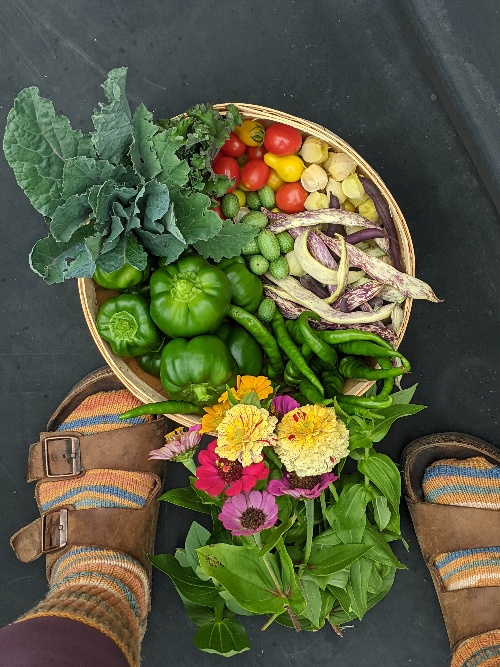
How much would you be willing to pay for a single snowdrop bulb?
Would you believe that a single bulb of a new snowdrop hybrid went for £1850 (about $2300) at auction a couple of years ago?
The prized cultivar is called Golden Tears, and it was developed by professional snowdrop breeder Joe Sharman. And get this! It wasn’t even his first record-breaking snowdrop sale. Talk about finding a niche!
Snowdrop collectors, called ‘galantophiles’ are getting even more competitive and seem to be developing an insatiable appetite for the 20 different species of snowdrops which encompass more than 500 named cultivars.

Now, I don’t know about you, but the most I’ve ever paid for a single snowdrop bulb was probably 99 cents. Yet the joy I get at seeing drifts of white bells in early February has always been priceless.
If money is not burning a hole in your pocket either, let’s talk about the easiest way to fill your gardens with these early harbingers of spring.
It’s called planting in the green!
And it’s the surefire way to make sure even the 99-cent bulbs thrive in your garden.
What does it mean to plant in the green?
When we’re planting in the green, we’re planting bulbs that are still actively growing. The “in the green” part refers to the fact that the bulbs have already sprouted leaves and sometimes even flowers when we’re putting them in the ground.

You know how we usually plant bulbs – either spring or summer bulbs – when they’re dormant? Yeah, planting in the green is the exact opposite of that.
The bulbs may be in the early growth stage, the blooming stage or the post bloom stage. All of these stages are considered “in the green.”
What bulbs can we plant in the green?
These bulbs will have a higher rate of success if we put them in the ground in their active growth stage:
1. Snowdrops (Galanthus)
Snowdrops are by far the bulbs most commonly planted in the green. In fact, you’ve probably noticed that you can’t buy snowdrop bulbs at the same time you get your tulips or daffodils, despite the fact that these are all spring bulbs.

But starting at the end of January and all throughout February, you’ll start seeing snowdrops sold “in the green.” They usually come either potted up (and you can plant them once the flowers have faded) or in a little bundle of green sprouts.
2. Winter aconites (Eranthis)
I’ve already dedicated an entire article to the many reasons why every gardener should plant these little drops of sunshine. Have a read here. And if not for our enjoyment, we should plant them for pollinators. Aconites are one of the first blooms of the year to open up for them.

Just like snowdrops, winter aconites are early bloomers. And just like snowdrops, they will get established more reliably if you plant them while they’re still actively growing. It’s a bit hit-and-miss to try to establish them from dry tubers, so start with live plants instead.
3. Bluebells (Hyacinthoides non-scripta)
Have you truly experienced spring if you haven’t seen a picture-perfect woodland carpeted in bluebells? I’m kidding, of course you have. But wouldn’t that be a nice feature to bring to your backyard?

You can get it by planting bluebells in the green in clumps of five to ten plants. They’ll naturalize reliably and you can divide them (also when they’re in the green) every five years.
Second chance bulbs
In addition to the three above, there are also some spring bulbs that we can plant either in the fall (as dormant) or in spring (in the green). So, if we forgot to put them in the ground last fall, we get a second chance to do so in late winter and early spring:
Ramson aka wild garlic (Allium ursinum) – have you tried the delicious leaves of this edimental?
Snakeshead fritillary (Fritillaria meleagris)
Wood anemone (Anemone nemorosa)
Star of Bethlehem (Ornithogalum umbellatum)

Spring cyclamen (Cyclamen coum)
Summer snowflake (Leucojum aestivum)
Wild tulips aka species tulips aka woodland tulips (Tulipa sylvestris)
Wild daffodils, especially the ones called Welsh daffodils (Narcissus obvallaris)

Early spring crocuses (Crocus tommasinianus)
Are there any advantages to planting in the green?
The advantage is that you get snowdrops. Seriously, don’t waste your time trying to get them established any other way, unless you’re a glutton for disappointment.
Unlike the larger bulbs that we plant in the fall, early spring bulbs (virtually all of the ones I listed above) are much smaller. The larger they are, the more energy they can store in the form of starches. The reverse is also true. Small bulbs can’t store as much energy when they’re dormant.

In addition to that, small bulbs dry out very quickly because they don’t have that thick leathery skin to keep the moisture inside the bulb. And once a small bulb dried out, that’s it! It’s dead!
So naturally, breeders and nurseries will only sell them when they’re alive (in the green). These plants will establish better because the leaves are still actively providing enough energy for the bulb.
And let’s face it, if you are the type of gardener willing to pay the big bucks for a collectable snowdrop, you’ll probably want to see it in bloom to make sure what you’re getting before the check clears.
Are there any disadvantages if I plant in the green?
There’s only one that I can think of.
You cannot procrastinate! (I am pointing at myself right now, just so you know.)
First of all, you can’t procrastinate on buying them because the window when bulbs in the green come up for sale is very short.
If you know you’ll probably forget, see if you can place a pre-order. Some online retailers will open for pre-orders about a month before the bulbs are ready. Then they’ll ship the bulbs as soon as they become available.

And once you have that box of bulbs delivered to your doorstep, you cannot procrastinate!
You should plant the bulbs in the green as soon as possible. There is a workaround if you buy them potted, like I did.
But if you’re getting them packaged, store them in the fridge in a damp cloth. Try to get them in the ground within the span of a few days. They’re not as forgiving to being forgotten as fall-planted bulbs.
So how do I plant in the green?
By now, I think you know all you need to know about the what and the why. Let’s move on to the how.
I will demonstrate planting in the green with some snowdrops because:
(1). It’s THE most common bulb that you should buy this way, and
(2). I really want more snowdrops!
I got the popular Galanthus elwesii in a cultivar called ‘Mount Everest’
Step 1: If you bought a batch, start by separating them into smaller bundles.
As I’ve already mentioned, there are two ways to buy snowdrops in the green.
You can get them either potted up, usually just a small bundle of five or so bulbs that are ready to bloom. This is how I usually find them when I buy them from the garden center. I like to keep them as blooming plants indoors for a few weeks before I take them out to the garden.

Or you can buy them soil-free, just wrapped up in plastic or paper. I found this second way of purchasing them more common with online retailers who just ship the bulbs from storage or straight from the ground from their own nurseries.
The nice thing about buying them bagged up is that the more you order, the cheaper they are. I usually see them for sale in multiples of 25. But whether you’re buying 25 or 500 bulbs, you will still need to separate them.

How many you plant in a bundle is up to you. I would recommend anywhere between three and five, depending on how full you want your snowdrops patches to look and how large of an area you want to cover.
But remember that snowdrops are prolific multipliers; so even if you only plant five, you might end up with a clump of ten in just a couple of years. It’s all a matter of balancing your plant budget against your willingness to delay gratification.
Step 2: Pick the right location and prep the soil.
You probably already instinctively know what spot snowdrops like, even if you’ve never planted them. Think about it where we usually encounter snowdrops in the wild: under deciduous trees, where the soil stays moist in winter and it doesn’t dry out in the summer.
You can also plant the bulbs around shrubs or bushes, but it’s always better to choose the ones that will lose their leaves in the winter. There will be just enough light penetrating through the canopy to encourage blooming.

Tucking snowdrops into nooks and crannies in your borders and your flower beds is also a good choice, as long as the spot you’re choosing isn’t one that gets bone dry at the height of summer. Remember that snowdrops are not an open meadow plant. We’ve already talked above why: how their bulbs are small and not protected by a thick husk.
A rich, moist and well-drained soil is critical, so see if you can improve your soil with some leaf mould or garden compost before you put the bulbs in the ground.
Step 3: Plant snowdrops at the same depth.

If you’ve bought your snowdrops potted up in soil, planting them is a breeze. Start by letting the soil dry for a couple of days. This will make it easier to slide everything out of the pot and get it into the ground. Make sure you bury everything at the same depth.
If you bought the bulbs unpotted, all you have to do is look for the white section of the stem. Or more specifically, where the leaves start changing color from pale white to green.

This is the depth at which the bulbs were planted. And this is also the depth at which you should replant them. Depending on the size of the bulbs, you’ll end up with about three to four inches of plant under the ground (8-10 cm).

Let’s talk about spacing.
You’ll want to give each clump of bulbs enough space to spread without overcrowding. But how much space that is will be up to you. If you prefer a more compact look, with tight drifts of white snowdrops, plant the bundles closer together. If you’re willing to wait a few years for the clusters to fill out, go ahead and spread them further apart.

I wouldn’t worry about this very much. I know that I can easily fix overcrowding by just lifting the bulbs and dividing them again – in the green – in a couple of years.

Once you’ve tucked the bulbs neatly, remember to keep them watered (but not waterlogged) if you’re having a dry spring. Mine is anything but dry, so I’ve decided to hold off on the extra moisture for now.
Step 4: Allow the snowdrop foliage to die back naturally.
If you’ve planted the snowdrops after they’re done blooming, like I did, you may think the clumps of limping leaves look kind of … dumb? They’re not the prettiest sight, I’ll admit to that, but please allow the leaves to die back naturally.

Even though it may look a bit unsightly, the foliage is what helps the bulb collect the energy it needs to bloom again and again.
If you’ve planted the bulbs in a spot where you think you may plant other things over the coming months, stick a label in the ground to remind you to leave them undisturbed.

Get the famous Rural Sprout newsletter delivered to your inbox.
Including Sunday musings from our editor, Tracey, as well as “What’s Up Wednesday” our roundup of what’s in season and new article updates and alerts.

